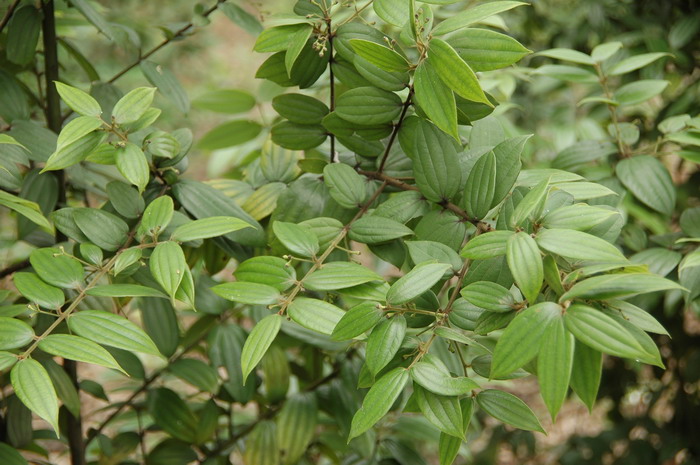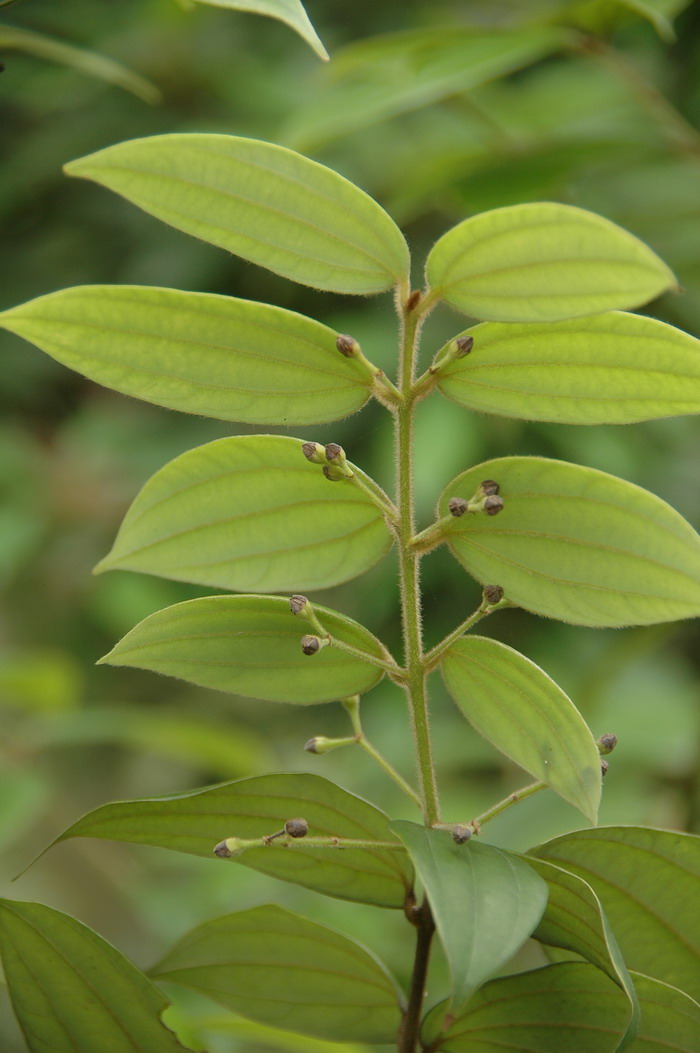毛桂Cinnamomum appelianum
中文名(Chinese Name):毛桂
学名(Scientific Name):Cinnamomum appelianum Schewe
英文名(English Common Name):
别名(Chinese Common Name):香桂子
异名(Synonym):Cinnamomum szechuanense Y. C. Yang Cinnamomum appelianum var. tripartitum Y. C. Yang Cinnamomum taimoshanicum Chun ex H. T. Chang Cinnamomum trinervatum Y. C. Yang Cinnamomum villosulum S. K. Lee et F. N. Wei
科属(Family & Genus):樟科(Lauraceae)樟属
形态特征(Description):寄生缠绕草本,借盘状吸根攀附于寄主植物上。茎线形,绿色或绿褐色,稍木质,幼嫩部分被锈色短柔毛,老时毛被稀疏或变无毛。叶退化为微小的鳞片。穗状花序长2-5厘米,密被锈色短柔毛;苞片和小苞片微小,宽卵圆形,长约1毫米,褐色,被缘毛。花小,白色,长不及2毫米,无梗。花被裂片6,排成二轮,外轮3枚小,圆形,有缘毛,内轮3枚较大,卵形,外面有短柔毛,内面几无毛。能育雄蕊9,第一轮雄蕊花丝近花瓣状,其余的为线状,第一、二轮雄蕊花丝无腺体,花药2室,室内向,第三轮雄蕊花丝基部有一对无柄腺体,花药2室,室外向。退化雄蕊3,位于最内轮,三角形,具柄。子房卵珠形,几无毛,花柱短,略具棱,柱头小,头状。果小,卵球形,包藏于花后增大的肉质果托内,但彼此分离,顶端有宿存的花被片。花、果期5-12月。
分布(Distribution):产湖南、江西、广东、广西、贵州、四川、云南等省区。生于海拔350-1400米山坡或谷地的灌丛和疏林中。
用途(Use):本植物对寄主有害,但全草可供药用,功能化湿消肿,通淋利尿,治肾炎水肿、尿路结石、尿路感染、跌打疖肿及湿疹,又可作造纸用的糊料。
引自植物志英文版FOC Vol. 7 Page 168, 185
Cinnamomum appelianum Schewe, Anz. Akad. Wiss. Wien, Math.-Naturwiss. Kl. 61: 20. 1925.
毛桂 mao gui | Lauraceae | Cinnamomum
Cinnamomum appelianum var. tripartitum Yen C. Yang; C. szechuanense Yen C. Yang; C. taimoshanicum Chun ex Hung T. Chang; C. trinervatum Yen C. Yang; C. villosulum S. K. Lee & F. N. Wei.
Small trees, 4-6 m tall, up to 8 cm d.b.h., several branched with branches opposite. Bark gray-brown or olive-green. Branchlets yellow-brown or chestnut-brown, terete, slightly robust, slightly scented, scattered with gray-brown and oblong lenticels; old branchlets glabrous; 1-year-old branchlets glabrate; current year branchlets densely covered with dirty yellow hirsute-tomentose hairs. Buds narrowly ovoid, acute; bud scales brown, imbricate, leathery, densely covered with dirty yellow hirsute-tomentose hairs. Leaves alternate or subopposite; petiole robust, 4-5(-9) mm, plano-convex, densely covered with dirty yellow hirsute-tomentose or villous hairs; leaf blade yellow-brown and opaque abaxially, green-brown and slightly shiny adaxially, elliptic, elliptic-lanceolate to ovate, or ovate-elliptic, 4.5-11.5 × 1.5-4 cm, leathery, densely covered with crisped dirty yellow pilose hairs along veins adaxially and densely so everywhere abaxially when young, glabrous adaxially and densely covered with crisped yellow hairs abaxially when mature, slightly wrinkled on both surfaces, triplinerved, midrib and basal lateral veins extending to leaf apex, basal lateral veins arising 1-3 mm above leaf base, arcuate-ascendant, with a few additional veins outside interconnected within leaf margin, transverse veins and veinlets numerous, ± conspicuous abaxially, base cuneate to subrounded, apex abruptly shortly acuminate. Panicle axillary on base of current year branchlet, generally much shorter than leaf, 4-6.5 cm, (3-)5-11-flowered, branched; branches ca. 0.5 mm; peduncle slender, elongate, 1-1.5(-3.5) cm, peduncle and rachis densely covered with yellowish brown hirtellous-villous or villous hairs; bracts linear or lanceolate, 2.5-3 × ca. 0.7 mm, caducous, villous on both surfaces. Pedicels 2-3 mm, very densely covered with yellow-brown hirtellous-pubescent or villous hairs. Flowers white, 3-5 mm. Perianth covered with yellowish brown sericeous-puberulent or villous hairs outside and inside but hairs longer inside; perianth tube obconical, 1-1.5 mm; perianth lobes broadly obovate to oblong-ovate, 3-3.5 × ca. 2 mm, acute. Fertile stamens 9, slightly shorter than perianth lobes, 2.5-3.5 mm; filaments pilose, those of 3rd whorl each with 2 sessile cordate-orbicular glands at middle part, others glandless; anthers oblong, 4-celled, those of 1st and 2nd whorls as long as filaments, cells introrse, those of 3rd whorl almost as long as filaments, cells extrorse. Staminodes 3, triangular-sagittate, 1.3-1.7 mm, shortly stalked; stalk villous. Ovary broadly ovoid, ca. 1.2 mm, glabrous; style robust; stigma peltate or capitate, entire or slightly 3-lobed. Immature fruit green, ellipsoid, ca. 6 × 4 mm; perianth cup in fruit dilated, funnelform, up to 1 cm, dentate and 7 mm wide at apex.
● Thickets or sparse forests on mountain slopes or in valleys; (300-)500-1400 m. Guangdong, Guangxi, Guizhou, Hunan, Jiangxi, Sichuan, Yunnan.
The bark is used medicinally as an astringent.


(责任编辑:徐晔春)
学名(Scientific Name):Cinnamomum appelianum Schewe
英文名(English Common Name):
别名(Chinese Common Name):香桂子
异名(Synonym):Cinnamomum szechuanense Y. C. Yang Cinnamomum appelianum var. tripartitum Y. C. Yang Cinnamomum taimoshanicum Chun ex H. T. Chang Cinnamomum trinervatum Y. C. Yang Cinnamomum villosulum S. K. Lee et F. N. Wei
科属(Family & Genus):樟科(Lauraceae)樟属
形态特征(Description):寄生缠绕草本,借盘状吸根攀附于寄主植物上。茎线形,绿色或绿褐色,稍木质,幼嫩部分被锈色短柔毛,老时毛被稀疏或变无毛。叶退化为微小的鳞片。穗状花序长2-5厘米,密被锈色短柔毛;苞片和小苞片微小,宽卵圆形,长约1毫米,褐色,被缘毛。花小,白色,长不及2毫米,无梗。花被裂片6,排成二轮,外轮3枚小,圆形,有缘毛,内轮3枚较大,卵形,外面有短柔毛,内面几无毛。能育雄蕊9,第一轮雄蕊花丝近花瓣状,其余的为线状,第一、二轮雄蕊花丝无腺体,花药2室,室内向,第三轮雄蕊花丝基部有一对无柄腺体,花药2室,室外向。退化雄蕊3,位于最内轮,三角形,具柄。子房卵珠形,几无毛,花柱短,略具棱,柱头小,头状。果小,卵球形,包藏于花后增大的肉质果托内,但彼此分离,顶端有宿存的花被片。花、果期5-12月。
分布(Distribution):产湖南、江西、广东、广西、贵州、四川、云南等省区。生于海拔350-1400米山坡或谷地的灌丛和疏林中。
用途(Use):本植物对寄主有害,但全草可供药用,功能化湿消肿,通淋利尿,治肾炎水肿、尿路结石、尿路感染、跌打疖肿及湿疹,又可作造纸用的糊料。
引自植物志英文版FOC Vol. 7 Page 168, 185
Cinnamomum appelianum Schewe, Anz. Akad. Wiss. Wien, Math.-Naturwiss. Kl. 61: 20. 1925.
毛桂 mao gui | Lauraceae | Cinnamomum
Cinnamomum appelianum var. tripartitum Yen C. Yang; C. szechuanense Yen C. Yang; C. taimoshanicum Chun ex Hung T. Chang; C. trinervatum Yen C. Yang; C. villosulum S. K. Lee & F. N. Wei.
Small trees, 4-6 m tall, up to 8 cm d.b.h., several branched with branches opposite. Bark gray-brown or olive-green. Branchlets yellow-brown or chestnut-brown, terete, slightly robust, slightly scented, scattered with gray-brown and oblong lenticels; old branchlets glabrous; 1-year-old branchlets glabrate; current year branchlets densely covered with dirty yellow hirsute-tomentose hairs. Buds narrowly ovoid, acute; bud scales brown, imbricate, leathery, densely covered with dirty yellow hirsute-tomentose hairs. Leaves alternate or subopposite; petiole robust, 4-5(-9) mm, plano-convex, densely covered with dirty yellow hirsute-tomentose or villous hairs; leaf blade yellow-brown and opaque abaxially, green-brown and slightly shiny adaxially, elliptic, elliptic-lanceolate to ovate, or ovate-elliptic, 4.5-11.5 × 1.5-4 cm, leathery, densely covered with crisped dirty yellow pilose hairs along veins adaxially and densely so everywhere abaxially when young, glabrous adaxially and densely covered with crisped yellow hairs abaxially when mature, slightly wrinkled on both surfaces, triplinerved, midrib and basal lateral veins extending to leaf apex, basal lateral veins arising 1-3 mm above leaf base, arcuate-ascendant, with a few additional veins outside interconnected within leaf margin, transverse veins and veinlets numerous, ± conspicuous abaxially, base cuneate to subrounded, apex abruptly shortly acuminate. Panicle axillary on base of current year branchlet, generally much shorter than leaf, 4-6.5 cm, (3-)5-11-flowered, branched; branches ca. 0.5 mm; peduncle slender, elongate, 1-1.5(-3.5) cm, peduncle and rachis densely covered with yellowish brown hirtellous-villous or villous hairs; bracts linear or lanceolate, 2.5-3 × ca. 0.7 mm, caducous, villous on both surfaces. Pedicels 2-3 mm, very densely covered with yellow-brown hirtellous-pubescent or villous hairs. Flowers white, 3-5 mm. Perianth covered with yellowish brown sericeous-puberulent or villous hairs outside and inside but hairs longer inside; perianth tube obconical, 1-1.5 mm; perianth lobes broadly obovate to oblong-ovate, 3-3.5 × ca. 2 mm, acute. Fertile stamens 9, slightly shorter than perianth lobes, 2.5-3.5 mm; filaments pilose, those of 3rd whorl each with 2 sessile cordate-orbicular glands at middle part, others glandless; anthers oblong, 4-celled, those of 1st and 2nd whorls as long as filaments, cells introrse, those of 3rd whorl almost as long as filaments, cells extrorse. Staminodes 3, triangular-sagittate, 1.3-1.7 mm, shortly stalked; stalk villous. Ovary broadly ovoid, ca. 1.2 mm, glabrous; style robust; stigma peltate or capitate, entire or slightly 3-lobed. Immature fruit green, ellipsoid, ca. 6 × 4 mm; perianth cup in fruit dilated, funnelform, up to 1 cm, dentate and 7 mm wide at apex.
● Thickets or sparse forests on mountain slopes or in valleys; (300-)500-1400 m. Guangdong, Guangxi, Guizhou, Hunan, Jiangxi, Sichuan, Yunnan.
The bark is used medicinally as an astringent.
(责任编辑:徐晔春)
踩一下[1]

顶一下[1]